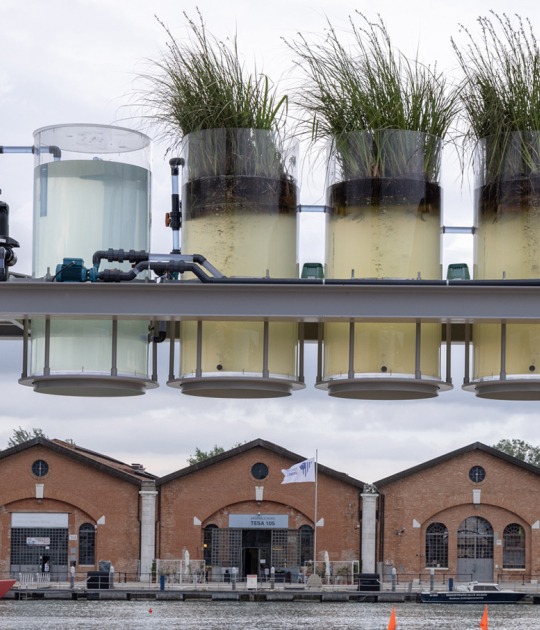Conceived by the artist as a travelling work, the significance of this pavilion will be felt beyond Venice. As it tours the international art scene it will become increasingly enriched so as to share with the world the most contemporary of what France has to offer. Since conceiving his idea, Xavier Veilhan has envisaged his Venice exhibition not as an end in itself but as the first step in an international journey. This travel dynamic corresponds fully to the philosophy behind the project, which functions, in the artist’s own words, as a “musical reflector”. Sensitive to the realities and geographical location of the installation, Xavier Veilhan has invited musicians who are the embodiment of their country or city – but also those just passing through on specific dates – and offers them a unique musical experience within the pavilion’s specially- designed space.
This guiding principle will change and manifest itself differently depending on the context. Thanks to invitations from several partners via the Institut français, Studio Venezia will soon after become Studio Buenos Aires then Studio Lisboa. The project will be presented in June 2018 at the CCK in Buenos Aires, then in the autumn at the MAAT, the Lisbon’s brand new museum of art, architecture and technology.
Description of the project by Xavier Veilhan
“I imagine an overall environment: an immersive installation that propels visitors to the world of the recording studio and that is inspired by the pioneering work of Kurt Schwitters, the Merzbau (1923-1937). Musicians from all backgrounds are invited to bring this recording studio-sculpture to life, as it becomes home to their creations during the seven months of the Biennale. The pavilion merges visual arts and music, with a nod not only to Bauhaus and the experiments of Black Mountain College but also Doug Aitken’s Station to Station.”
Xavier Veilhan
The French pavilion for the Venice Art Biennale 2017 will be transformed by Xavier Veilhan and the pavilion’s curators, Christian Marclay and Lionel Bovier, into a musical space in which professional musicians from all over the world wil work throughout the duration of the exhibition.
It is no accident that the word “studio”, in both English and Italian, is used to denote a place that houses both musiciansand artists. Teamwork is one of the central pillars of Xavier Veilhan’s atelier, and he has always expressed his desirefor collaboration, in contrast to the common perception of the “lone creator”. Studio Venezia is fully in keeping with this desire, bringing together musicians, sound technicians, programmers and producers, amongst others.
In this immersive installation that blurs the architectural lines initially drawn up for the French pavilion (designed in 1912 by the Venetian engineer Faust Finzi), floors, walls and ceilings collide to form a landscape of wood and fabrics that reveals a fully operational recording studio. Inspired by additive and intuitive construction methods. This overall artwork evokes not only Kurt Schwitter’s Merzbau but also the phonic devices used during recordings.
Numerous instruments, which will be integrated into the space, will enable musicians from different horizons and genres (from classical to electronic and from new music compositions to folkloric styles) to work on site, either individually or collaboratively. The presence of sound technicians and an impressive guest list of musicians will ensure the possibility to experiment with sound, at the same time as encouraging unexpected collaborations. Musicians will be free to decide how they wish to use their time in the pavilion and they will retain full ownership of their performances, thus leaving with their own recordings and a compilation of their work with others.
Rather than attending concerts, visitors will instead be invited to listen, watch and bear witness to musical creations in progress. One-off actions will replace shows, and consumption will make way for discovery - as contemplative as it may be - as individuals move around the installation. Visitors will attend these sessions more by accident than through planning, as the pavilion’s activities stretch out over the 173 working days of the Biennale, and the list of musicians present will only be partially unveiled in advance. The project’s creator, who will be present during the seven months of the Biennale, hopes the pavilion will become a living, breathing space rather than a passive receptacle for predetermined programmes.
Around a hundred musicians from various countries will come to Venice to work, think and play for audiences of art lovers who are not necessarily there to hear them play. The team behind the project hopes it will be seen as the only one of its kind today that enables a form of interaction that breaks away from a cultural industry which declares itself the keeper of both the “fringe” and the “unplugged”. The cards that, when dealt, lead to the same old hierarchies between renowned, experimental and amateur musicians will be reshuffled, leading to a responsive programme that visitors won’t know in advance. Digital means will be utilised in order to prolong and entich the visitor’s experience. An application will broadcast the pavilion’s sound feed in real time.






















![Friedrich Kiesler, Endless House for Mary Sisler [shattered sketch sheet], New York and Florida, 1961, 21.5 x 33.4 cm, pencil on paper, mounted on cardboard. Courtesy by the Austrian Frederick and Lillian Kiesler Private Foundation, Vienna Friedrich Kiesler, Endless House for Mary Sisler [shattered sketch sheet], New York and Florida, 1961, 21.5 x 33.4 cm, pencil on paper, mounted on cardboard. Courtesy by the Austrian Frederick and Lillian Kiesler Private Foundation, Vienna](/sites/default/files/styles/mopis_home_news_category_slider_desktop/public/2025-05/metalocus_Fundacio%CC%81n-Frederick-Kiesler_03_p.jpg?h=3b4e7bc7&itok=kogQISVW)












